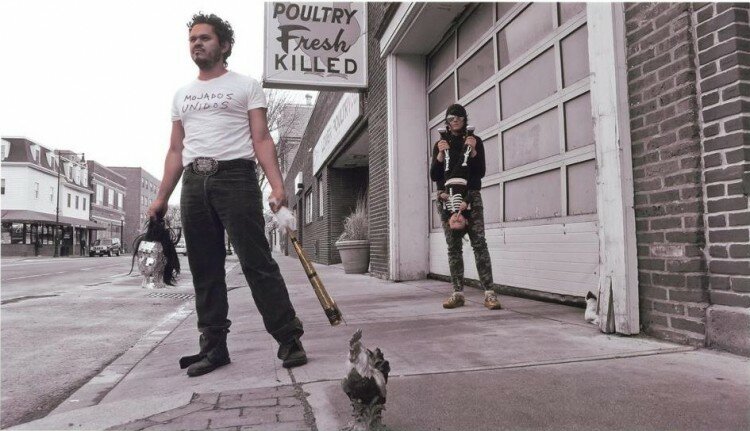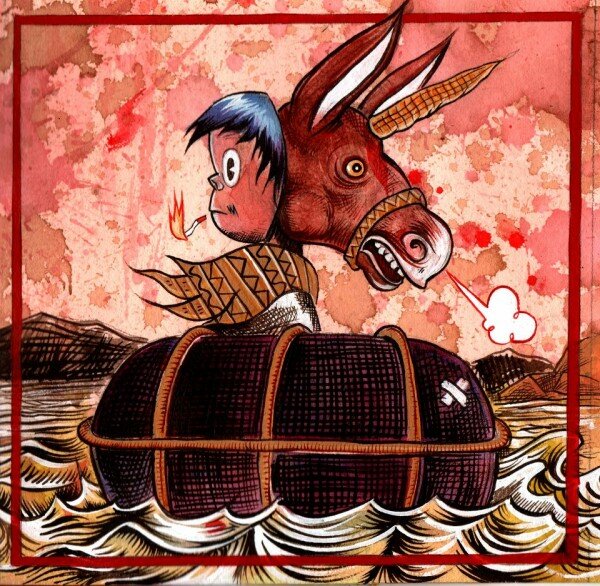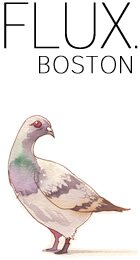(Hola)
“I feel like I’m creating the work that I’ve wanted to create since I was a little boy. And the first influences I had as an artist, were artists who were either in comic books, on tv or in cartoons. And those were works of art that were very accessible to a boy like me who grew up in a place that didn’t have the Museum of Fine Arts or The Institute of Contemporary Art. So the spinner rack at the local 7-11 was my Museum of Fine Arts and I like for my artwork to be very accessible to people who might not have museums in their lives. My work is a true reflection of my love of this art form.”
Check out the rest of the feature I wrote for this month’s issue of Spirited Magazine, after the jump!
—————————————————————
(Artist Raul Gonzalez with wife Elaine and upside-down son, Raulito. Image via Juxtapoz)
Over the course of Raul’s life, from border town to big city, his visual vocabulary has been shaped by a polarizing, yet strangely cohesive array of images, memories, and experiences that imbue his work with a refreshing sense of rawness, honesty and accessibility.
(Born Again)
“I think the early years of any person are the most important years of your life because they end up defining who you are going to be. And my upbringing defines who I am today. I grew up on the Westside of El Paso and would often cross over the border to spend time with cousins in Juarez. As a boy, I knew we were leaving El Paso behind once the roads turned to dirt. My father’s family is from Ysleta, the oldest European settlement in the USA, and we would often go and visit my grandmother. It is kind of an undeveloped city, more rural than the city of El Paso and less hectic than the hustle and bustle of Juarez. Cowboy boots, spittin’ loogies, fighting roosters, rock fights, and tumbleweeds are all images and memories that shaped my visual vocabulary early on.”
The artist grew accustomed to shifting landscapes as his family frequently changed homes during his early years. Raul immersed himself in the Arts hoping for some semblance of stability and found that no matter where he went, drawing proved to be an essential tool for adapting to changes outside his own control and fitting in with new groups of people.
“I attended nine different schools before I graduated, and I have always found that art was my icebreaker. If I could draw something, I could meet people quickly. I would have students lined up at lunchtime to have me draw Garfield or sketches of their girlfriends. And then in highschool I became a journalist nerd and drew for the yearbook, the poetry magazines, and the newspapers. It was a great way for me to understand that my artwork could find a place and be valuable. People looked to me to illustrate ideas in a different way and it was during this time that I also learned how to collaborate with groups of individuals. I came to understand that I was just a part of something much greater than myself.”
(La Cubeta from the collection of Samantha Milowsky)
Over time, the perpetual state of transience wore on the young artist and left Raul feeling completely uninterested in putting forth effort in school, a decision that took a serious toll on his grades. Fortunately, he was able to survive the ennui of highschool through a part time job at a local comic book store, an opportunity that proved to be an invaluable education in itself.
“I worked at a comic book shop for two years and started to really study a lot of the illustrators, I mean really study. While I loved all the characters, I was much more interested in the people that were making the books, and I would read interviews in hopes of learning about and replicating their techniques. I became a human Xerox machine. I was pretty good at copying styles which later proved helpful because now when I look back, I can recall specific techniques used by certain artists and incorporate them into my own pieces. I was really good at mimicking specific styles and now I’m just an amalgamation.”
(El Mojon)
While Raul’s work is rooted in the language of cartoons and comics, the majority of his compositions are surprisingly macabre. Figures impaled by swords, beheaded, hung or disfigured are fairly commonplace in his paintings. That being said, and dismemberment aside, there is still something hauntingly enchanted about his creations. It comes from a deeper place of experiences, stories, and an exploration of life as opposed to caricatured violence for the sake of shock. After surveying the less than lighthearted subject matter of his work, I couldn’t help but wonder if Raul censors any work for his young son, Raulito.
“My son sees everything, he’s two, he doesn’t know what a body without a head is or why there is a body lying on the ground and actually he adds a lot to my work constantly.”
At this point, Raul fans out some work from his portfolio and points to seemingly erratic, yet endearing, flourishes of crayon.
(Los Dos)
“Raulito often comes up to me while I’m working on a piece and point to something he likes. Then he’ll grab his crayon and add his own little mark to it and say ‘nice!’ and that’s nice for me. He has always been a part of the process.”
In Boston, a mini metropolis notorious for cultivating creative talent that later leaves for the bright lights of bigger cities, many younger artists look to Raul as an inspirational figure, thinking “If he can do it, I can do it.” Although the humble artisan is not one to sing his own praises, it is undeniable that Raul has come a long way from his days sketching pictures of classmates and cartoon characters in the unfamiliar halls of ever-changing schools.
While still in the early stages of his career, Raul has already shown his work at some of the largest galleries, museums, and institutions in the region with no signs of slowing down. He has truly commanded the attention of the Art world through paintings and pigments that all but bleed his strong sense of culture and storytelling.
Despite all the success, awards and accolades, Raul remains grounded. He has not lost sight of his community and happily works on murals for local businesses, lectures at schools with little to no Arts programs, and is proud to show his work alongside an espresso machine in a local cafe, or beside a million dollar work of art at the MFA.
(detail of concept drawing for “Merrily…”, future mural project at Tufts University)
“I feel one of the reasons I’ve become somewhat successful in my art career is because I’ve always been very open and receptive to trying new things. I have never shied away from anything, and in saying ‘no’, you can miss out on a really incredible opportunity. Life is strange in that you are never really in control of the outside, but if you practice and love what you are passionate about you can surround yourself with things that are close to what you want. You have to be willing to share. Eventually you just become what you are and that’s that.“ ♥











